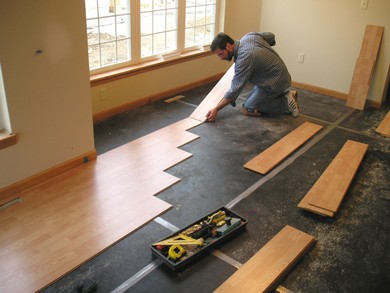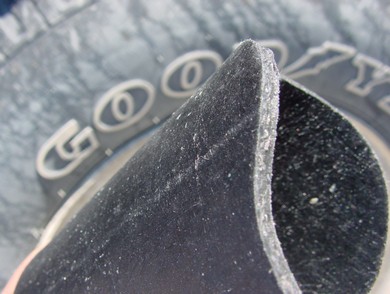If you’re planning to upgrade the flooring in your home, you’ve got to realize that there’s more to floor quality than what you see. It’s also about what you hear. Every time an old carpet gets ripped up in favour of laminate, engineered wood floor, bamboo plank or ceramic tiles, there’s a pretty good chance that the homeowners involved are in for a disappointing lesson in the physics of sound transmission. Hard floors teach hard lessons.

Today’s hard flooring options may be popular for their good looks, but they also transmit sound with disappointing clarity. That’s why you’d be wise to invest in quality underneath your floor as well as what you see on top. And one of the most effective places to put your soundproofing dollar is a type of product that begins as a massive heap of old rubber tires.
When it comes to floors, the main acoustic challenge isn’t just about keeping the sound of voices, television and music from spilling over into other levels of your home or neighbouring condos. An added task is halting the transmission of medium frequency thuds caused by people walking around, children dropping toys or the movement of heavy objects on floors above. In fact, this can be the most difficult acoustic hurdle to clear, especially if you’re committed to a hard surface flooring. I’m not a big fan of wall-to-wall carpet, but I have to admit that a nice thick carpet and underlay does block a fair amount of sound transmission through the underlying floor.
Sound engineers measure the transmission of impact noises such as walking and objects being dropped. on a scale called Impact Insulation Class (IIC). A good rating for a residential floor is around 50 IIC, though it’s quite common for unprotected hard surface floors to only reach the high 20s or low 30 IIC. That’s not great. Even if you’re separated from your upstairs condo neighbours by 8 inches of reinforced concrete, the moment they switch from carpet to ceramics (or any other hard surface floor), you’ll know exactly when they get up to go to the bathroom at night. The solution to both these problems is found in the application of a dense, rubber underlay. Typically about 3mm (3/16″) thick, think of it as high performance shock absorbers for your floors.
A handful of different brands of sound-reducing rubber underlay are on the market, but one of the most innovative is manufactured by a Canadian company called NRI Industries. It turns more than a million old tires each year into products for automotive and industrial applications, as well as an acoustic rubber floor underlay called QuietDown (knrubber.com 800-387-8501).
Independent lab testing of this product by the Institute for Research in Construction (a branch of the National Research Council), shows that Sound Down increases the impact rating of engineered hardwood applied over 8 inches of bare concrete from an IIC of 34 to a whopping 61. That’s an impressive number indeed. It costs about $1.20 per square foot.

One of the most effective uses of acoustic rubber underlay is in all those homes built before the emergence of plywood as a subfloor material. Prior to the 1970s, subfloors were always built with boards typically 6” to 8” wide, laid diagonally across floor joists. Sizable gaps almost always exist between these boards and they let huge amounts of sound pass from one floor to another. So much for the good old days of homebuilding.
But installation of acoustic rubber underlay over these old-style subfloors is one of the most effective ways to reduce the torrent of floor noise. And when used in conjunction with a screw-anchored plywood subfloor added on top, the system gets rid of squeaks better than anything else. If you’re renovating your home, it would be foolish not to use some kind of rubber underlay below hard flooring.
QuietDown is also the only acoustic rubber underlay I know of that’s rated specifically for use directly underneath ceramic tile. Nestle the 4-foot x 8-foot or 3 1/2-foot x 4-foot flexible sheets into a coat of thinset adhesive applied to a stable subfloor, then put ceramic tiles on top with more thinset.
One of the most encouraging things about today’s homebuilding scene is the extent to which innovation is making a difference. Even in an industry as slow-to-change as the construction business, a flood of new ideas really is leading to better homes. And when it comes to creating good floors, the rubber has really hit the road.